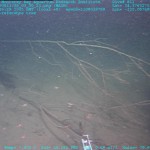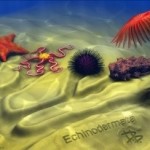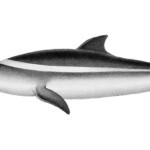
Some of us never grow up. In fact I am writing this now in my Aquaman pajamas while laying on Return of the Jedi bedsheets*. Unlike my childlike tendencies, for other species sometimes delayed growth can be advantageous in nature. Take Xyloplax. New work suggests that its development may be stunted as an adaptation to its favored unique habitat. And no I am not talking about a college fraternity or high school locker room.
To fully appreciate Xyloplax, you need to understand something. Xyloplax has a rather enigmatic history. Within the echinoderms are five living classes: Ophiuroidea or the brittle stars, Echinoidea or the sea urchins, Holothuroidea or the sea cucumbers, Crionoidea or the sea lillies, and Asteroidea or the sea stars. When discovered, the small and rare Xyloplax did not really fit in anywhere among Echinoderms. It had features that clearly made it an Echinoderm but not that clearly put into one of the classes above. For example, Xyloplax has no arms! So it was suggested that Xyloplax, the unique and special snowflake it is, receive its own new sixth class.

But perhaps we shouldn’t get carried away and start handing out taxonomic classes like Republicans handing out tax breaks to the rich. Many, including the good ol’ Dr. Mah have hypothesize Xyloplax is an actual Asteroid with arrested development so that sexually mature individuals occur in an otherwise juvenile body (i.e. progenesis). A new scientific paper using DNA and developmental data from adult and embryonic Xyloplax supports this idea. Xyloplax appears most closely related to the chunky little, mucus producing, bastards of the family Pterasteridae.
What would the advantage be of being an armless juvenile with functioning gonads? One, you get more interesting Friday nights. Second, Xyloplax inhabits pieces of wood that fall to the deep seafloor. Being small and disc-like allows Xlyoplax to fit into small spaces in a decaying piece of wood to consume bacteria.
So the next time you tell someone to grow up, consider they may be perfectly adapted to thier niche on this planet.
*Part of this statement may not be true.
Janies, D., Voight, J., & Daly, M. (2011). Echinoderm Phylogeny Including Xyloplax, a Progenetic Asteroid Systematic Biology DOI: 10.1093/sysbio/syr044






To be fair, Janies’ was the first to publish on the “Xyloplax as progenetic” (or heterochronic). I think the idea in general has merit-the question is a progenetic WHAT.
Also-a lot of the first accounts actually did indicate that Xyloplax’s closest relatives were most likely asteroids-albeit very distantly related…
And my own personal opinion here is that calling these animals “just starfish” rather seriously misrepresents just how complicated they are.. that’s just my opinion though..Let’s just say that the story of Xyloplax has just entered a soon to be more active stage…